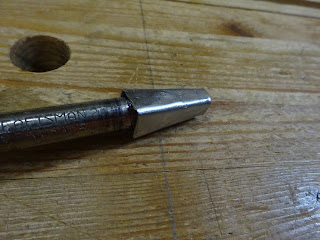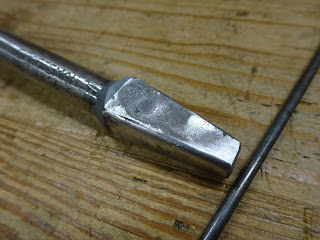I saw these two large (unusual sized) auger bits at a tool show last year and ever since then I've kicked myself for not buying them. Well, there was another tool show recently and I found them again, but remembered why I didn't pick them up last year - the larger one had had its square tapered shank cut off, presumably for use in a drill press. Sacrilege!!!!
 |
| 1 1/8" and 1 1/4" diameter Craftsman bits |
I tried using it with my largest brace, a 12" Fray, but the two-jaw chuck could not tighten sufficiently to keep it from slipping as I tried to bore a hole.
One of the guys at the show offered to help me fix it - he's a metal worker and would probable be able to weld on a donor shank. But he lives a little far from me, so I thought about it and decided to try something myself. I don't know if this will stand the test of time, but for now it is working.
 |
| I first traced the shank from the 1 1/8" bit onto a piece of metal, then cut it out and bent it into approximate shape |
 |
| Here's the too-large shank next to the two bits |
 |
| After cutting and filing it down a little, a test fit on the round shank. I had filed a bit of a square taper on the round shank for a better fit. |
 |
| Then I filled the new shank with JB Weld and stuck the bit into it and let it set up for a couple of days |
 |
| I had a piece of 7/64 wire, so drilled that size hole to pin the new shank in place |
 |
| Here, you can see the pin if you look carefully. I had epoxied the pin in place, then peened the ends and filed them down. |
 |
| And a test cut worked perfectly. |
I'm really happy about this. I hope it works permanently, but only time will tell. If I bore holes in tougher wood, the stresses might crumble the JB Weld. But it's good for now. Being able to save an old tool (maybe this one is not too old) and put it back to work is so damned satisfying!
Very clever, I had no idea what you were going to do until the photo of the epoxy. Hope it works for a long time!
ReplyDeleteMe too, Jeff. Time will tell.
DeleteWhat are the sizes of the bits? They appear to be identical, which raises my next question: if they are the same, why bother fixing it? Is the tapered part centred on the shank? If so, you're exceptionally skilled. When I was constructing the stand and had to bore a hole either 1 1/4 or 1 1/2 inches, I can't recall exactly it was quite challenging. At one point during the boring process, I was worried the brace or bit might break. It demanded a lot of torque, so I'm pleasantly surprised that yours has endured. Perhaps your bit was built better, making it sturdier than mine. I'm not sure, but well done. Very professional.
ReplyDeleteHi Salko. I listed the sized in the caption of the first photo - 1 1/8" and 1 1/4". It's not perfect, but I got a reasonably good centering of the tapered shank with the shaft. That took a little fiddling before gluing it together. I'm fortunate that the bit has excellent threads in the lead screw and perfect cutting lips and spurs. That makes the bit go through the wood a bit easier. But I've yet to prove it in a hard wood - we'll see what happens then.
DeleteYou know I'm blind as a bat. I look for something on the grocery shelves and the product stares at me yet I still cannot see it until someone points it out to me. Sounds like an unused bit, pity someone else cut the taper off. If it cuts well in softwood it should cut even better in hardwood givng you a much cleaner hole. Great post Matt
ReplyDeleteBrilliant! It should last a good while. I've used the plumber's putty version to fix a hole in the crankcase of 2 different motorcycles. It held up for decades.
ReplyDeleteNext time I see a butchered auger bit, I might give it a go myself
That's fantastic! I guess it takes a willingness to try something. What could go wrong? (LOL)
DeleteHappy days brother
ReplyDelete